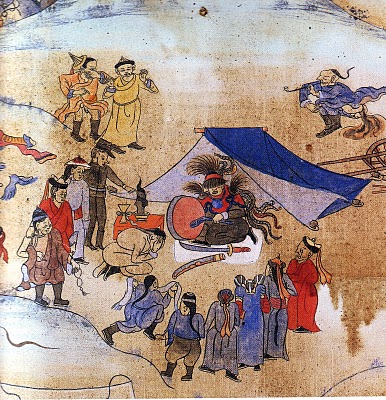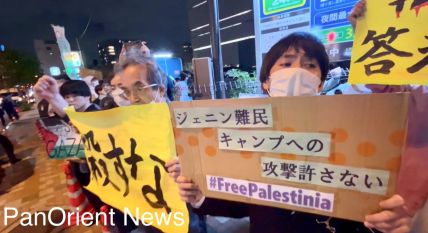|
|
Other
Feature: Religion Reenters Daily Life in Post-Soviet Mongolia
Monday, July 5, 2010
 Mongol Shaman
Mongol Shaman
Ulan Bator -- Overlooking Ulan Bator stands the landmark Zaisan Monument, built in 1970 by Russians as a tribute to soldiers who died during the Second World War. The mural art depicts arresting scenes of friendship between Mongolians and Russians during times of war and peace.
But obscured beneath the propaganda are details of the destruction and havoc that the Soviet years wreaked on religious and cultural life in Mongolia. Monasteries, mosques, and churches were pulverized to unite the country into the fist of homogenous communism.
Now, twenty years after the collapse of the Soviet Union, Mongolia is witnessing a spiritual revival and religious diversity like never before.
At the restored Dashichoilin monastery, a monk shows me around the temples which had been used as warehouses by the Soviets. These are the only surviving wooden temples built in the shape of the traditional Mongolia dwelling, called "ger."
A part of the temple, converted into a circus training school, is yet to be reclaimed.
"We ask the government always and we sent even a letter to give it back to us to use it again as a temple, but they haven't answered yet," says Naranbat, the administrative monk of the monastery.
Mongolia is a predominantly Buddhist country, but the religion faced a serious setback during communist rule when over 13,000 monks were executed.
With people eager to rediscover their faith, international Buddhist organizations are trying to address some of the challenges of reviving Buddhism.
"The most difficult aspect since the 1920 occupation is that there is a lack of qualified teachers and texts, and this is because the teachers were killed and the texts were burnt or destroyed. So the materials and the teachers, the materials and the teachings, the living traditions, have really been wiped out," says Glenda Lee, an Australian nun who works for the Foundation for the Preservation of Mahayana Tradition, an organization that moved into the country in 1999.
In another part of town, a Muslim group gathers to offer their Friday prayers.
Islam, practiced by the ethnic Kazakh population in Mongolia, is also making a comeback. This group too wasn't spared the persecution of the Soviet years.
"All religions were affected during communist rule, including Islam. Imams were arrested and mosques destroyed. We faced the same situation as Buddhists and shamans," says Batirbyek Khadis, president of the Mongolian Muslim Societies Federation.
While small groups gather in makeshift prayer rooms across the city, a giant mosque is being built with Saudi Arabian assistance, which will soon allow them to worship together under one roof. Once complete, this will be one of the largest standing religious places of worship in the city.
Across town, Christian churches form part of the city skyline.
Missionaries flocked in with democracy and over 180 churches are now spread across the country. Apart from older Orthodox establishments, new reformist movements like the Mormon Church have gathered.
The controversial Unification Church also has many followers, as do Jehovah's Witnesses and Seventh Day Adventists.
Shamanism, too, has lately been wooing believers back to the traditional folk beliefs which were pushed to the fringe by Buddhism in the 16th century and moreso by the Soviets.
It is not uncommon for many Mongolians, even ardent Buddhists, to take their personal problems to shamans to mediate with the spirits.
Religious tolerance was one of the governing principles of Chingis Khan's Mongolian Empire, and the explosion of faiths does seem a sign of present day tolerance in contemporary Mongolia.
"The government has supported Islam and granted us land to build our place of worship. I think there is no other country like Mongolia that allows for freedom of religion. Before the government recognized only three religions - Buddhism, Islam, and shamanism, but now many religions are coming into the country, even those banned by other countries," says Khadis.
But what is driving so many Mongolians to seek spiritual comfort?
The transition from socialism to a market economy has been a traumatic one for many Mongolians, and desperate poverty is a new phenomenon that continues to be the country's biggest hindrance to development.
"I think it's interesting that after a period of occupation, in any country or culture, that there's a natural curiosity, a natural resurgence of interest in the things we were not allowed to do during this time. I also think that there is a lot of poverty here, a lot of difficulties generally, so the people are looking for answers, to make sense of it all and also to find increasing happiness," says Lee.
"Right after communism crashed we had a kind of vacuum, when we had no ideology and people started to think that the main ideology is money, to make money and have a good life, and after that people started to understand that money is not the only means to become happy," adds Odgerel.
However, religion has not helped solve the present-day problems of poverty and corruption the country is still grappling with, and not everybody is enthusiastic about the newfound religious fervor.
"Mongolians are now always talking bad about the past and worshipping the new age with a lazy mind. Communism had its bad side, but it made people work hard and created a comfortable life for everybody. Democracy is creating a culture of finding easy money. Religion is now being used as a way to become rich," opines Shaman Zorigbaatar.
For a country going through a rapid transition, religious freedom has given many a safety net of spiritual comfort, but for many others left out of this spiritual sanctuary, one can only hope that economic and social freedom will follow not too far behind.
Pearly Jacob
PanOrient News
© PanOrient News All Rights Reserved.
|
|

